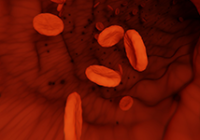By Dr. Martin Hart, DC, founder of Keystone Total Health

“Get your head on straight!”
“Is anyone at home up there?”
“It feels like I’m carrying the whole world on my shoulders.”
We’ve all heard these statements before in conversation. They’re used figuratively to illustrate certain frustrations, but they actually relate quite literally to our own neck and head. During school, you may have learned about the Greek mythology of Atlas, the man holding up the globe or world. It’s no coincidence that the top-most vertebra in our spine is also named the atlas vertebra, as its job is to structurally hold up our globe, a.k.a. head.
When it is misaligned–shifted out of place–it feels as if our head is not on straight or like our brain is out to lunch and no one’s at home. Sometimes this causes head and neck pain, but this misalignment can result in many other seemingly unrelated symptoms.
Atlas misalignment is when your first cervical vertebrae, the top-most bone in your spine, has shifted out of place. As little as a 1-2mm shift can make a big difference in our body, disrupting your spine, blood flow, cerebrospinal fluid flow, hormones, stress response system, and other body functions. The tiny muscles that connect to your atlas serve a very specific purpose, they give detailed feedback to your brain about the state of your spine and body. When out of sync with the rest of your spine and cranium (your head), the feedback is more like static than clear communication. These issues are further compounded due to restricted cerebrospinal fluid flow and blood flow in and out of the skull. This means fewer nutrients and less oxygen reaching your brain resulting in more cellular “junk” become stagnant.
How do you know if your atlas is out of alignment? The best way to diagnose an atlas misalignment is a physical examination from a specialty trained chiropractor. Further testing methods are x-ray, CT Scans, and MRI.
Before you jump on these tests, let’s see if you fit the symptoms:
- Neck Pain
- Headaches
- Head pressure
- Dizziness/Vertigo
- Poor balance
- TMJ issues
- Vision disturbances
- Muscle spasms, twitches, or cramps
- Shoulder pain
- Low back pain
- Upper back pain
- Nerve pain down shoulders and arms
- Nausea
- Poor coordination
- Difficulties with speech
- Derealization/depersonalization
Furthermore, atlas misalignment is associated with various conditions such as craniocervical syndrome, multiple sclerosis, upper cervical instability, Chiari malformation, chronic traumatic encephalopathy, and vertigo. In my practice, 95% of the patients who are chronically ill also have an atlas misalignment. If you have neuro-toxicity, heavy metals, mold illness, or Lyme disease, it’s vital that your brain has adequate blood flow and cerebrospinal fluid movement.
In essence, if the head can’t drain out the toxins, then the toxins simply remain stagnant creating a big mess. Not only that, when the atlas has shifted out of its natural alignment, it can impede recovery and healing for many seemingly unrelated conditions.
One major condition associated with atlas misalignment is upper cervical instability or craniocervical syndrome. This is when your atlas consistently shifts out of place due to weak or damaged surrounding ligaments. This can create many neurological symptoms and can be very difficult to diagnose at first, especially if you don’t know to look for an issue in the upper neck.
How do the ligaments get so weak or damaged? Genetic factors such as hypermobility (being “double-jointed”) and Ehler-Danlos syndrome can make ligaments too loose. Injuries like whiplash from a car accident can over-stretch the ligaments, making them weak and flimsy. Infections, such as borrelia that causes Lyme disease, can destroy the collagen in connective tissue or may trigger autoimmune conditions like Mixed Connective Tissue Disease. These are all some ways that ligaments can become too loose. The best way to diagnose upper cervical instability is with a motion x-ray that assesses excess movement of the atlas.
Ok, so it sounds like you may have an atlas misalignment. Now what? A chiropractor trained in upper cervical treatments can apply a specific yet gentle correction to align your atlas and restore proper function to the joints in the upper spine. If instability is a factor that continues to create atlas misalignment then you need to find the root cause and address that. Other treatments that can help with atlas misalignment include:
- Chiropractic care
- Physical therapy
- Low-level laser therapy
- Stem cell treatments
- Structural Energetic Therapy (SET)
- Platelet-Rich Plasma (PRP) injections
- Nutritional therapy and supplementation
- Boron, copper, manganese, lysine, and vitamin C
- Collagen peptides
- Glucosamine, MSM, and chondroitin
- Aloe vera gel
- Probiotics
- Surgery (always a last resort!)
If you are dealing with the aforementioned symptoms—or any other chronic complaint for that matter–do not neglect this root-cause solution as it could prove to be the key that unlocks a major shift toward healing for you. In our office, we check every single patient for atlas misalignment because we feel it’s such an important factor.
###
Any medical information contained herein is provided for informational purposes only; it is not advice, nor should it be treated as such. If you have any healthcare-related concerns, please call or see your physician or other qualified healthcare provider. Educational information provided by the Marion Institute or any employee of the Marion Institute is NOT intended as a substitute for a healthcare provider’s consultation: if you have a health concern, please do not delay in seeking medical guidance from a health care professional. The Marion Institute and its employees make no representations, nor any warranties, nor assume any liability for the content herein; nor do we endorse any particular product, provider, or service.












This Post Has 0 Comments